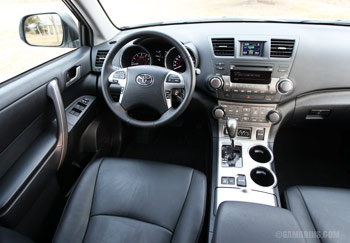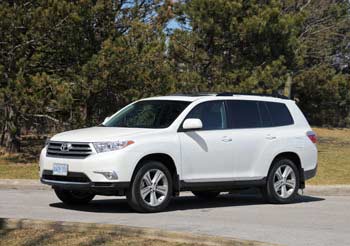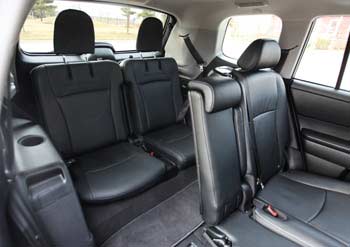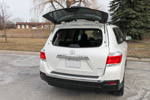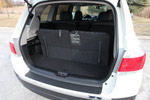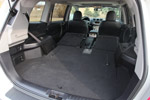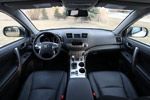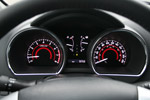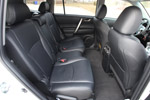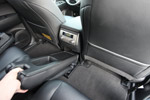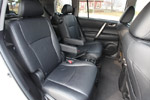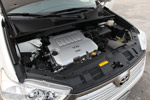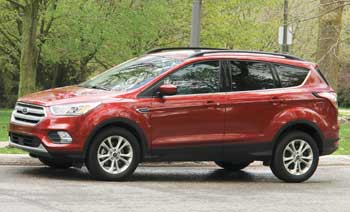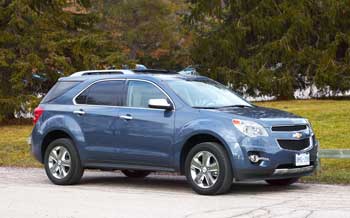2008-2013 Toyota Highlander: pros and cons, common problems
By Vlad Samarin Updated: February 18, 2024
The Toyota Highlander is a dependable mid-size SUV.
It offers a roomy interior, smooth and quiet ride, and a strong optional V6.The Highlander comes as a 5 or 7-seater, with front- or all-wheel drive. Engine choices include a 2.7L 4-cylinder (FWD only) or 3.5L V6. The hybrid model has a 3.3L V6.
With ample cargo space and up to 5,000 pounds of towing capacity, the Highlander is one of the best road trip cars.
Pros:
- Dependability: The Toyota Highlander is known for its dependability and can potentially last for over 200,000 miles without major problems.
- Spacious Interior: With ample seating and cargo space, the Highlander offers versatility for both passengers and luggage.
- Smooth Ride: The Highlander provides a comfortable and smooth ride, ensuring a pleasant driving experience.
- Strong Resale Value: Toyota's reputation for reliability contributes to the Highlander's strong resale value, making it a wise investment for used car buyers.
Cons:
- Plain Interior Design: Some may find the Highlander's interior design to be functional but mot luxury.
- Third-Row Space: The third-row seating in the Highlander may feel cramped for taller passengers, especially on longer journeys.
- Higher Price: Compared to some rivals, the Highlander is more expensive, though its long-term reliability offsets this cost.
- Outdated Infotainment: The infotainment system lacks the latest connectivity and entertainment options. The screen is small too.
Another area of complaints is 'Electrical Systems'. Some owners report that the door or hatch ajar warning light comes on when driving when it's closed. Other owners report the alarm going off randomly.
A number of owners have also reported an issue with the driver's sunvisor. All these are fairly minor problems compared to ones found in other SUVs. Let's look at some of the problems closely.
The door ajar warning light could come on when driving over bumps for several reasons. This video, for example, shows the problem with the rear hatch latch causing this issue. Here is another video explaining the diagnostics of this issue with a scan tool. The same problem can cause the alarm to go off randomly.
A faulty hood latch switch can also cause the alarm to go off sporadically. We found this YouTube video describing the problem with the hood switch.
According to the service bulletin T-SB-0047-10, the Check Engine light with codes P0351 - P0356 Ignition Coil Primary/Secondary Circuit) in the 2GR-FE engine could be caused by a bad ignition coil. The affected ignition coil must be replaced with an updated part. Front ignition coils (Bank 2) are easy to replace. Replacing one of the rear ignition coils (Bank 1) will cost up to 2.5 hours of labor plus the part. When replacing a bad coil, we would also recommend replacing all spark plugs if they are old. We found several videos on this subject.
Problems with u-joints in the intermediate steering shaft can cause various issues with the steering, including a rattling or clunking noise, looseness or occasional stiffness. Replacing an intermediate shaft costs from $380 to $640; it's not a very difficult job. Watch these videos describing the problem and the repair.
The Toyota service bulletin (TSB) 0348-09 for the 2008-2009 Highlander mentions the problem where a faulty neutral start switch can cause the engine to start in Neutral but not in Park. A revised neutral start switch assembly is available to solve this problem, according to the bulletin.
The TSB-0184-09 describes an issue with the throttle body that can cause the code P0505 in the 2GR-FE engine. According to the bulletin, the PCV hose connections and air induction system must be inspected for leaks. If no leaks are found, the throttle body must be replaced.
Advertisement
There were some issues with leaking water pumps in earlier models. Replacing a water pump costs $320-$580 in a 4-cylinder engine and $750-$1,100 in a V6, as reported by Highlander owners.
Since various oil and coolant leaks are mentioned, it's a good idea to keep all the fluids topped up and check the vehicle for leaks regularly. Drops of oil on the driveway are an early sign.
Summary
The Toyota Highlander is not only comfortable to drive, but is one of the most reliable mid-size SUVs. As of February 2024, Consumer Reports marks the 2010, 2012 and 2013 model years of this generation as 'Recommended'.We looked through hundreds of Toyota Highlander owner reviews, and the majority are positive. Many owners praise roominess, second-row space and car-like handling. Nearly all mentioned a comfortable and quiet ride. Complaints include things like real-world mpg, material quality (some interior plastics feel hard) and cargo space with the third-row in use.
Overall, the Highlander is the best option among mid-size SUVs and will last long with proper care. One feature in this generation Highlander we recommend to stay away from is the power liftgate; it might be expensive to repair if it fails.
Related reviews:
Nissan Pathfinder 2013-2019
Honda Pilot 2009-2015
Honda Odyssey 2011-2017
Toyota RAV4 2006-2012
Mazda CX-9 2007-2015
Toyota Venza 2009-2015
Jeep Cherokee 2014-2020
Ford Edge 2007-2014
Toyota Highlander 2001-2007
What to look for when buying a used Toyota Highlander: It might be a good idea to opt for a 2009 or newer Highlander, as first-year models always have more issues. Avoid the car if the engine rattles when started cold. Watch out for coolant/oil leaks in the engine compartment and under the car. Check if all the windows go up and down smoothly. Test the rear-passenger climate controls to see if the rear heater and air conditioner work properly. There should be no clunks or rattle felt in the steering when driving slowly on a rough road. During the test drive, watch out for drivetrain noises; see if the transmission shifts smoothly. Have the vehicle properly inspected by an independent mechanic or used car inspector before buying; it can save you a lot of money. Read also: How to inspect a used car - illustrated guide and
Signs of automatic transmission problems when test driving a used car.
Engines: The most common engine choice is a 270-hp 3.5L V6, model 2GR-FE; it's one of the best V6 engines on the market. A 187-hp 2.7L 4-cylinder engine, model 1AR-FE is available only with front wheel drive. Both are solid, reliable engines. The 2008-2010 Highlander Hybrid comes with a 3.3L V6, model 3MZ-FE mated to a hybrid drive. The 2011-plus Highlander Hybrid has a 3.5L V6.
Timing belt or chain: Both the 2.7L 4-cylinder 1AR-FE and the 3.5L V6 2GR-FE engines have a timing chain; however, the 3MZ-FE engine in the 2008-2010 Highlander Hybrid does have a timing belt. According to the Warranty and Maintenance Guide for the 2010 Highlander Hybrid, a timing belt must be replaced every 90,000 miles or 108 months.
| Toyota Highlander EPA Fuel Economy: | mpg city/hwy |
L/100 km city/hwy |
| 2011-2013 3.5L V6 AWD hybrid | 28/28 | 8.4/8.4 |
| 2008-2010 3.3L V6 AWD hybrid | 27/25 | 8.7/9.4 |
| 2009-2010 4-cyl FWD | 20/27 | 11.8/8.7 |
| 2011-2013 4-cyl FWD | 20/25 | 11.8/9.4 |
| 2008-2013 3.5L V6 FWD | 18/24 | 13.1/9.8 |
| 2008-2010 3.5L V6 AWD | 17/23 | 13.8/10.2 |
| 2011-2013 3.5L V6 AWD | 17/22 | 13.8/10.7 |
Handling and Ride: The Highlander is a pleasure to take on a long road trip; the ride is smooth and quiet. The soft suspension soaks bumps and road imperfections well. The steering feels light. Overall, it's a very comfortable vehicle to drive, whether around town, or on the highway.
Interior: In a 7-seat configuration, the 40/20/40 split second-row seat has a small "Center Stow" middle seat that can be removed and stored in the driver's centre console. The third-row is more suitable for kids. The liftgate glass opens separately in all but base models; a power liftgate is available in top trims.
Photos:
AWD System Maintenance: The Highlander AWD system has two major components: the transfer case and the rear differential. We checked the maintenance schedule for the 2013 non-hybrid Highlander and it recommends inspecting the fluids in the transfer case and rear differential every 15,000 miles, but changing the fluids for normal driving conditions is not mentioned. However, when "Driving while towing, using a car-top carrier, or heavy vehicle loading" the fluids must be changed every 15,000 miles, according to the schedule. We would recommend changing the rear differential and transfer case fluids at least every 60,000 miles, even when driving in normal conditions. These components also need to be inspected regularly for leaks. Using only the same-size tires and having them inflated to the recommended pressure is also important for the AWD system's health.
